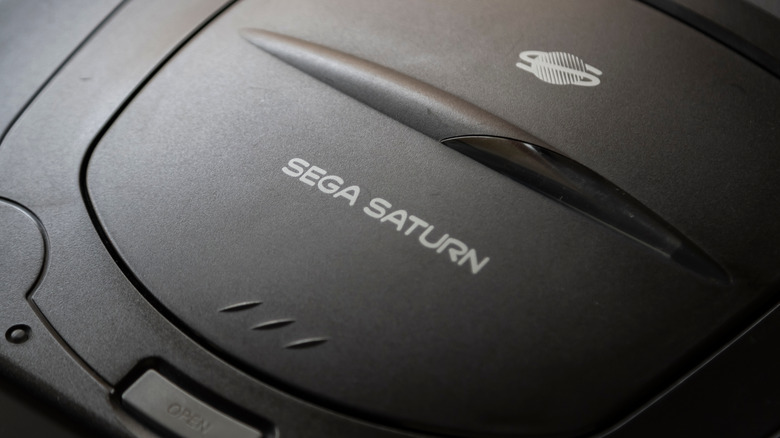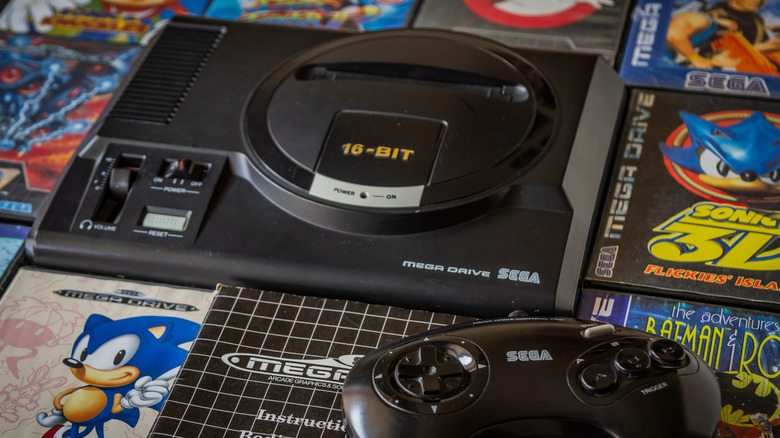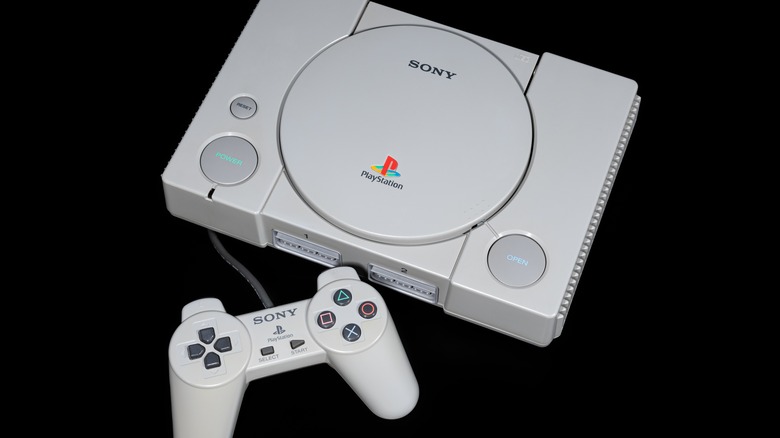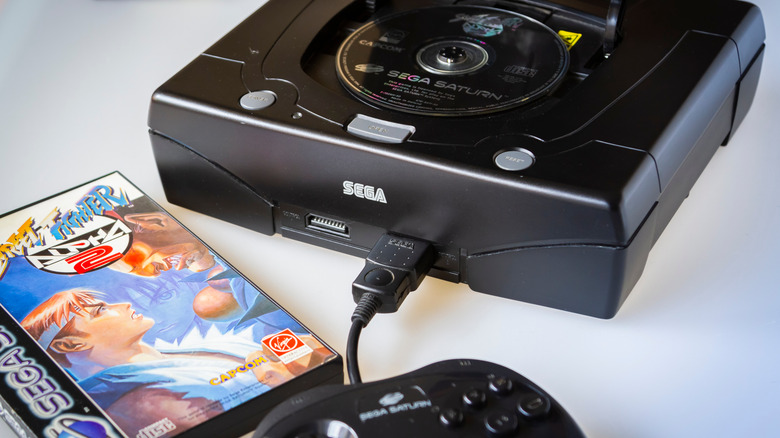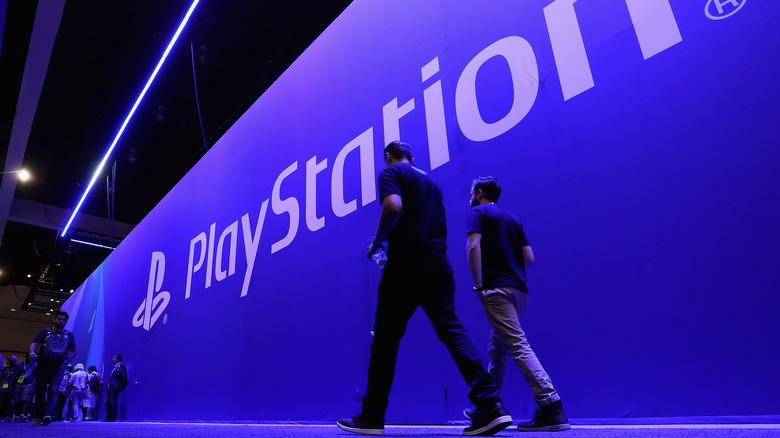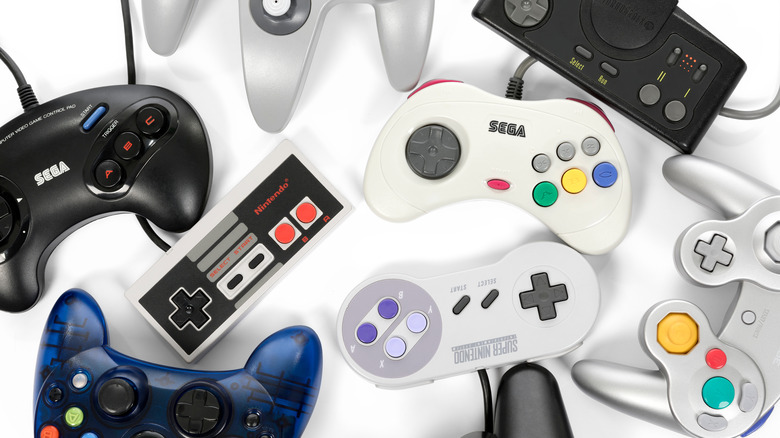What Happened To The Sega Saturn?
Today, Sega works with Microsoft, Sony, and Nintendo rather than competing with them, but it was once a major player in the video game industry's "console wars." Surely, the Sega Saturn could have been a victory lap for the one company that could slug it out with Nintendo.
Thirty years ago, the home console race was a dead heat between the Sega Genesis and its rival, the Super Nintendo Entertainment System. The snipes these two titans of industry took at one another were vicious. Sega snidely sang in its advertising that "Genesis does what Nintendon't" (via Nintendo Life), while Nintendo's own "Donkey Kong Country 2" on SNES dumped Sonic the Hedgehog's iconic red shoes in a trash pile labeled "No Hopers," But by the mid-'90s, Sega had lost ground to Nintendo in sales, and another major competitor was poised to enter the race, so the company decided it needed a hot new console to get back on top. Enter the Sega Saturn.
Sega surprise-launched the Saturn four months early in May 1995, at an Electronics Entertainment Expo (E3) trade show event that kickstarted a new rivalry with Sony. Ultimately, Sega's eagerness to get a head-start on the next-generation console race would come back to haunt it, as it struggled to compete with Sony's popular new PlayStation and the more powerful Nintendo 64. The Saturn's failure soon proved to be more than a stumble, but its stellar library has helped the console gain a fresh following today.
16 bits is not enough
The 16-bit Sega Genesis (or Mega Drive outside of America) was the company's biggest hit yet as a console maker, and the first competing home console to take a bite out of Nintendo. Launched in 1988 in Japan and '89 in the U.S., the Sega Genesis soon gained a wide library of fast and flashy games — including "Sonic the Hedgehog," "Streets of Rage," "Mortal Kombat" and Electronic Arts' entire EA Sports line — that helped it sell 29 million units to the Nintendo's 49.1 million in the cramped '90s game market. Sega's success is even more impressive considering Nintendo's dominance in the late 1980s with the original Nintendo Entertainment System — a near-monopoly so unbreakable that by 1990, the company put out posters reminding customers that not every video game product is called "a Nintendo" (via Kotaku).
But Sega made a number of controversial decisions during the Genesis' life, and it was driving customers away. In order for Sega to keep up with its monster rival, it resorted to selling expensive add-ons to the base Genesis console, confusing customers and sowing mistrust in the market. With Sega players dropping hundreds of dollars on the Sega CD disc drive and powerful yet bulky 32X peripheral just to play the latest Genesis games, players were starting to turn to the much simpler Super Nintendo Entertainment System.
PlayStation on the horizon
A multicultural operation since its founding by American businessmen in Japan, Sega in the early '90s was torn between the needs of Sega of Japan and Sega of America. The Genesis was a resounding success in the U.S. that SOA president Tom Kalinske wanted to preserve, but Japan's leadership was eager to move on, as the Mega Drive wasn't as enthusiastically received by the domestic market. SOA wanted to capitalize on the existing Genesis user base with stop-gap add-ons like the 32X, while SOJ wanted to focus on an entirely new, more powerful console.
Internal quibbles at Sega needed to be quashed quickly, however, as the company faced a looming threat: Sony, which was preparing to dive headfirst into the market. Its new PlayStation console would be CD-based, with high-quality audio and impressive 3D graphics. It was everything the Genesis had tried to be — and it would be out in Japan next year. Sega needed a follow-up now.
Kalinske turned to the press. In a September '93 Electronic Gaming Monthly article, he name-dropped the Saturn for the first time in an almost offhanded way, boasting that Sega's flagship arcade hardware was so powerful that launching a comparable home console could happen "more or less tomorrow." The race for the 32-bit generation was on.
Approaching Saturn
With Sega of America president Tom Kalinske casually announcing the 32-bit Saturn in an Electronic Gaming Monthly interview, the hype was rolling for Sega's new console. And the race was on internally, too, as Sega's engineers and designers worked to have the Saturn ready in time to go toe-to-toe with the PlayStation. Throughout 1994, Sega unveiled unfinished versions of the Saturn and its games at various trade shows, running stunning demos and conversions of eye-popping arcade titles like "Virtua Fighter" and brand new 3D experiences like "Panzer Dragoon." Finally, it would be ready to launch in Japan in November the same year, just eight days before the Sony PlayStation.
Even with a week's lead, Kalinske knew personally that Sony could clobber Sega. He had already done business with Sony Electronic Publishing president Olaf Olafsson on the Sega CD. But Sony had also worked with Nintendo — and got burned. After Sony engineer Ken Kutaragi created the SPC700 sound chip for the Super Nintendo Entertainment System, their next planned joint project, the "Nintendo PlayStation," had fallen through at the last minute. Kutaragi's personal determination to succeed despite a failed business deal had spurred the Sony PlayStation into reality.
With both the Saturn and PlayStation out in Japan, Sega and Sony set their sights on the 1995 Electronics Entertainment Expo (E3). Both came ready to leave the other in the dust.
E3 1995
May 1995 held the very first Electronics Entertainment Expo, or E3. And the Los Angeles-based event was set to blow up as Sega and Sony — which had both launched their latest 32-bit consoles in Japan — geared up to unveil their new hardware to the North American market.
Sony PlayStation designer Ken Kutaragi had already launched a "global charm offensive," as The Guardian puts it, wowing developers with graphics demos flexing the might of the console. Sega, instead, was split East and West, as Sega of Japan focused on the Saturn and Sega of America continued to court Genesis players with new games and expensive peripherals. The Saturn sold steadily despite this, but the PlayStation was gaining steam.
To cut off Sony before it gobbled up the American market, SOJ president Hayao Nakayama pushed his SOA counterpart to do the unthinkable. At Sega's May E3 presentation, which kicked off the company's surreal "Theater of the Eye" marketing campaign for Saturn, SOA president Tom Kalinske delivered a keynote presentation where he announced that the Saturn was launching four months early. In fact, it was on store shelves right now for $399.
It seemed to Sega like this surprise maneuver would be enough to stymie the PlayStation. But during Sony's own E3 event, head of development Steve Race stepped on to the stage to say just one thing (via YouTube): "$299."
'The Saturn is not our future'
With a chaotic Electronics Entertainment Expo (E3) conference in the books, Sega's new Saturn was set to fail. The surprise launch of the console upset retailers, who shared a meager supply of units at only the largest stores. And the launch library was tiny, with new games not set to arrive until 1996 — when the Nintendo 64 would launch with the 3D action platformer "Super Mario 64." What Sega needed was a surefire hit. They needed Sonic the Hedgehog.
But Sonic never showed up. Sega published compilations and spin-offs on the Saturn like "Sonic Jam" and "Sonic R," but never offered fans a full-fledged, brand new experience on par with Nintendo's "Mario 64." Yuji Naka and Naoto Ohshima, designers of the 16-bit Sonic games, were busy at work on "Nights into Dreams," a spectacular 3D game about Jungian psychology and flight. This left Sega of America all alone to work on the ill-fated "Sonic X-treme" — what would have been Sonic's big 3D debut on the Saturn. Allegedly, Naka's insistence on not sharing his 3D engine for "Nights" with the "X-treme" staff contributed to the project's failure.
Without Sonic, Sega lost its opportunity for a flagship game with its company mascot. While the console would eventually build up a respectable library, both presidents of Sega in Japan and America resigned by 1997, leaving the new SOA president Bernie Stolar to famously declare at E3 '97 (via Fatnick Industries), "the Saturn is not our future." Sega Saturn was dead.
